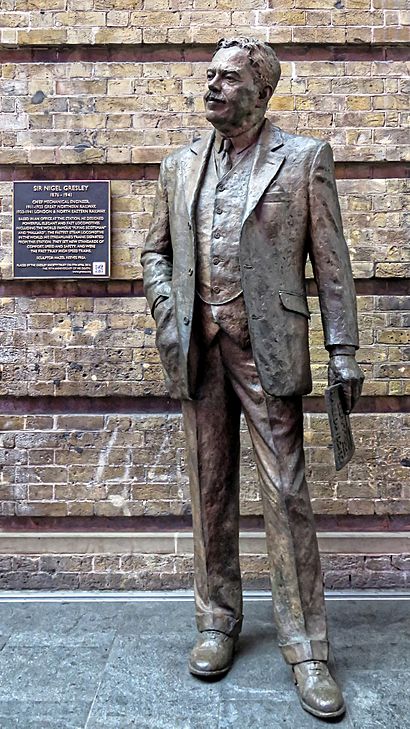Statue of Sir Nigel Gresley facts for kids
Quick facts for kids Statue of Sir Nigel Gresley |
|
|---|---|

The statue and plaque
|
|
| Subject | Nigel Gresley |
| Location | London, United Kingdom |
A statue of Sir Nigel Gresley stands proudly at London King's Cross railway station. This bronze statue honors Sir Nigel Gresley, a famous locomotive designer. He had offices right there at the station. One of his most famous designs was the Mallard. This amazing train set a world speed record for steam locomotives in 1938. That record still stands today!
The Gresley Society asked for the statue to be made. It was designed by Hazel Reeves and created at the Whitechapel Bell Foundry. There was a bit of a debate about the statue. The original design included a small duck, but it was removed from the final sculpture. Many people wanted the duck to stay. Over 3,200 people signed a petition to bring the duck back!
Contents
Who Was Sir Nigel Gresley?
Sir Nigel Gresley was a brilliant engineer. He was the chief mechanical engineer for the London and North Eastern Railway (LNER). This means he was in charge of designing and building trains. He oversaw the creation of 2,150 locomotives. He also helped design tens of thousands of train cars.
Gresley's work changed how trains looked and performed. His designs were known for being fast and efficient. He is remembered as one of the most important figures in railway history.
The Gresley Society and the Statue's Idea
The Gresley Society is a group of about 500 people. They work to keep Sir Nigel Gresley's memory and work alive. They want to celebrate his amazing achievements. In 2012, the society received a large gift of £500,000. This money came from a member's will.
The society asked its members how to use this special gift. They decided to create a memorial for Gresley. At first, they thought about a bust, which is just the head and shoulders. But later, they chose a full-length statue. People also donated money, raising an extra £13,000.
How the Statue Was Made
Sculptor Hazel Reeves was chosen to create the statue. She was paid £95,000 for her work. Hazel used an old method called lost-wax casting. This is a traditional way to make bronze sculptures.
First, she made a clay model of Gresley. She built it around a metal frame called an armature. Then, she added his clothes to the clay model. This clay model was used to make a mold. From that mold, a wax version of the statue was created. Finally, the bronze statue was cast at the Whitechapel Bell Foundry. The whole process, from planning to putting up the statue, took 18 months.
What the Statue Looks Like
The statue is about 7 feet (2.1 m) tall. This means it's about 120% of a real person's height. Gresley is shown standing with his right hand in his jacket pocket. He might be reaching for his pipe. In his left hand, he holds a technical magazine.
Hazel Reeves said she wanted the statue to show Gresley "in a moment of quizzical reflection." This means he looks like he's thinking deeply. She also wanted him to be "looking out towards the future." The magazine he holds is a copy of The Locomotive. The cover of the magazine shows his famous Mallard train.
Unveiling the Statue
The statue was officially revealed on April 5, 2016. This date was special because it was 75 years since Gresley passed away. Important people attended the ceremony. Sir Peter Hendy, who leads Network Rail, was there. Gresley's family members also came to see the statue.
The statue stands very close to the King's Cross booking office. It's also just a few steps from where Gresley's own office used to be. A plaque on the wall behind the statue tells about Gresley's career. It mentions his famous trains, the Mallard and the Flying Scotsman. The plaque also notes Gresley's strong connection to King's Cross station. Many of his trains started their journeys from there. It also credits Hazel Reeves as the sculptor and the Gresley Society for commissioning the work.
Images for kids




